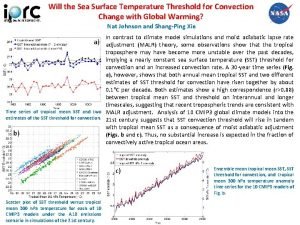Will the Sea Surface Temperature Threshold for Convection

- Slides: 1

Will the Sea Surface Temperature Threshold for Convection Change with Global Warming? Nat Johnson and Shang-Ping Xie In contrast to climate model simulations and moist adiabatic lapse rate a) adjustment (MALR) theory, some observations show that the tropical Time series of tropical mean SST and two estimates of the SST threshold for convection. b) troposphere may have become more unstable over the past decades, implying a nearly constant sea surface temperature (SST) threshold for convection and an increased convection rate. A 30 -year time series (Fig. a), however, shows that both annual mean tropical SST and two different estimates of SST threshold for convection have risen together by about 0. 1°C per decade. Both estimates show a high correspondence (r>0. 88) between tropical mean SST and threshold on interannual and longer timescales, suggesting that recent tropospheric trends are consistent with MALR adjustment. Analysis of 10 CMIP 3 global climate models into the 21 st century suggests that SST convection threshold will rise in tandem with tropical mean SST as a consequence of moist adiabatic adjustment (Figs. b and c). Thus, no substantial increase is expected in the fraction of convectively active tropical ocean areas. c) Scatter plot of SST threshold versus tropical mean 300 h. Pa temperature for each of 10 CMIP 3 models under the A 1 B emissions scenario in simulations of the 21 st century. Ensemble mean tropical mean SST, SST threshold for convection, and tropical mean 300 h. Pa temperature anomaly time series for the 10 CMIP 3 models of Fig. b.

